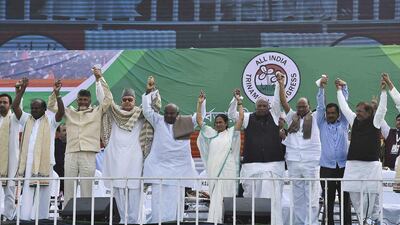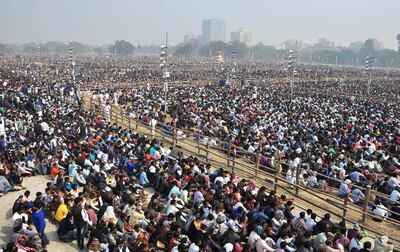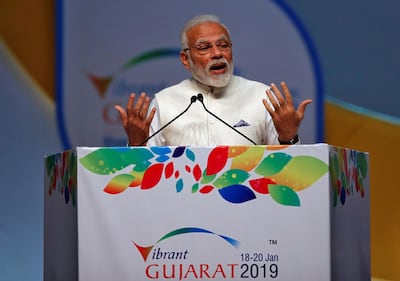Dozens of political parties across India are preparing to unite into a mega-coalition to take on Prime Minister Narendra Modi’s Bharatiya Janata Party (BJP) and its allies in a general election this summer.
In the most significant pre-election event of the year, leaders from 23 parties and 14 states shared a platform at a rally in Kolkata on Saturday. Half a million people attended the rally, according to the West Bengal state government.
Leader after leader rose to speak against Mr Modi and the BJP, following the tone set by Mamata Banerjee, the chief minister of West Bengal. Ms Banerjee called the BJP “fascist” and said, of the event: “It is as if the country has come together against the BJP.”
Nearly all of the parties were regional players, dominant in one or a handful of states. The only national party to rival the BJP, the Congress, sent one of its veteran politicians, but its president Rahul Gandhi did not attend.
At least two more similar rallies are planned, in Amaravati in the south and in New Delhi. H D Deve Gowda, the leader of the Janata Dal (Secular), the party governing the state of Karnataka, said the participants in the proposed coalition must soon write a joint election manifesto.
The BJP has mocked the move, claiming that the country still supported Mr Modi and his policies. “Of the 23 people who were seated [on the rally stage], there are nine who want to be prime minister,” party president Amit Shah said at a rally of his own in the West Bengal town of Malda on Tuesday. ”We only have one leader.”
The putative coalition will be the biggest such opposition alliance since 1977, when a dozen parties came together to defeat then prime minister Indira Gandhi after she placed the country in a state of emergency for two years.
The fact that parties which are otherwise rivals, such as the Bahujan Samaj Party and the Samajwadi Party – both regional powers in Uttar Pradesh state, are coming together reflects “the concentration of power in the hands of the government”, said Nitin Pai, director of the Takshashila Institution, a think tank in Bengaluru.
The BJP has dominated Indian electoral politics since Mr Modi came to power in 2014. Although the BJP has junior allies in the coalition that governs India, Mr Modi has arrogated so much policy-making power to himself that it has “pushed political leaders away and into each other’s arms”, Mr Pai said.
Peer Mohamed Azees, who runs Ippodhu, a political analysis website, said Mr Modi’s government threatened the independence of institutions such as the election commission, the Reserve Bank of India, and federal investigating agencies. He also mentioned the “thoughtless” exercise of demonetisation in 2016. “The anger of the people is finding [an outlet] in this coming together of disparate forces,” he said.
But the coalition is also a matter of necessity, said Sandeep Shastri, a political scientist at Jain University. The BJP has been so adept at winning state-level elections over the past four-and-a-half years that the coming together of these parties “is also for their survival”, he said.
“The non-BJP parties are united in their opposition to the BJP … but there is no positive glue to hold them together,” Mr Shastri said – neither shared ideologies nor political objectives beyond keeping the BJP out of power.
The lack of ideological glue may handicap the coalition, said Milan Vaishnav, who directs the South Asia programme at the Carnegie Endowment for International Peace in Washington.
“If the opposition emerges victorious, expect the contradictions to begin surfacing right away,” he said. “Perhaps the most apt analogy is the period between 1996 and 1998 when India was ruled by a series of rickety coalitions and no fewer than four prime ministers.”
In an earlier era, the regional parties might all have united around the Congress, India’s oldest political party and the only one, aside from the BJP, to have enjoyed a true pan-national influence. But the Congress “is a shell of its former self, having been decimated in the 2014” general elections, Mr Vaishnav said.
For this reason, analysts see the Congress as only one of several poles of opposition to the BJP. For the mega-coalition to succeed, Mr Shastri said, the Congress will have to subdue its ego and its ideas about its own importance. “It will be crucial … but its leadership will not be central to the emerging coalition.”
In a best-case scenario, Mr Vaishnav predicted, the Congress might win about 100 seats in the election – better than its 2014 tally of 44 seats, but still a fraction of the 543 seats in the Lok Sabha, the lower house of parliament.
“At that strength, the party could be in a position of kingmaker, but it won’t have the strength to rule outright,” Mr Vaishnav said.



